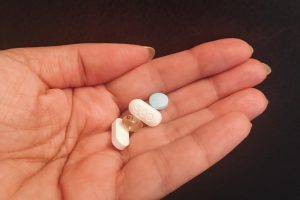Keflex (cephalosporin antibiotic) prevents bacterial cell wall formation and stops pathogens from multiplying. It can treat respiratory and urinary tract infections and middle ear infections. Cephalexin is available in the form of capsules, liquid, or tablets. It also addresses the problem of bacteria resistance. Keflex is an antibiotic that is effective across many bacteria. Learn about using Keflex antibiotics, side effects, warnings, and more.
Keflex is a first-generation Cephalosporin sold under other brand names such as Ceftab, Keflet, Cefanex, Biocef, Zartan, and Ceporex.
What is Keflex antibiotic used to treat?
Keflex can treat conditions like:
- Bacterial infection
- Streptococcus infection
- Otitis media
- Tonsillitis
- Lower and upper respiratory infections
- UTI
- An infection of the tissue below the skin
- Dental infections
Is Keflex a strong antibiotic?
Keflex is a broad-spectrum antibiotic that is effective across many bacteria. It has excellent activity against streptococcus pneumonia, staphylococcus aureus, S. pyrogens, Proteus mirabilis, and Moraxella catarrhalis. Even better, the effect of Keflex kicks in one hour after you take it. However, you could take up to 48 hours to see the results.
Keflex works well on infections caused by gram-positive and gram-negative bacteria.
How quickly does Keflex Work?
Keflex works by binding the activity of enzymes, a critical component of the bacterial cell wall. After interfering with the formations, this kills the bacteria. Generally, the cell keeps the contents of the cell together, making it harder to survive.
Because it’s bactericidal, the antibiotic works similarly to penicillin. Depending on your condition, you’ll feel better for most infections after a few days. However, you must take the entire course as advised by the doctor to prevent the disease from returning. Keflex will not work for colds and other virus infections.
How is Keflex antibiotic used?
This medication is taken by mouth, usually every 12 hours, with or without food. Larger doses may be administered for severe infections. Your doctor may recommend treatment for up to 14 days.
The dosage will depend on the strength of the medicine. Generally, the drug you take daily will depend on your medical problem. For example, adults should take 250mg every 6 hours or 500mg every 12 hours. For children below 15 years, the doctor may recommend 50 to 100 mg per day.
You should take the antibiotic as prescribed by the doctor. Don’t use Keflex to treat a condition that is yet to be checked by the doctor.
Using the suspension, you should shake the bottle and measure the dose carefully- use the provided measuring spoon.
The drug you take will depend on what you want to treat, your age, and how you react to the first dose. For the best effect, you should take the drug simultaneously every day. Even if the symptoms improve, you should continue with the medication. Tell your doctor if the symptoms get worse.
What illnesses does Cephalexin treat?
Cephalexin can treat the following conditions:
- Upper respiratory tract infection
- Prostatitis – acute inflammation of the prostate
- Cystitis
- Poor skin composition or soft tissue infection
- Genitourinary tract infections
- Pharyngitis
- Osteomyelitis
- Bacterial endocarditis prophylaxis
- Ear infection
- Yeast infections
- Streptococcal infections
This antibiotic works by killing or preventing bacteria growth.
Side Effects of Keflex antibiotic
The side effects of Keflex are rare (1 in every 1000 people).
Some rare but not common side effects include:
- Indigestion
- Abdominal pain
- Fatigue
- Headache
- Increased creatine
- Vaginal discharge or itchiness
- Nausea
Most of these side effects will go away on their own. They adjust with the body after you finish the medication.
You should call your doctor if:
- You get bruised skin.
- Experience severe diarrhea, or your stool contains blood.
- Yellowing of the whites of the eyes – could be a sign of a liver problem.
- You have trouble breathing.
- Your mouth and throat start swelling.
- You have a severe renal impairment.
Before you take Keflex, you should know whether you’re sensitive to Cephalexin.
This product will rarely cause severe intestinal conditions. However, if you experience blood in your stool, you should stop the medication immediately and call your doctor.
You should tell your doctor if you’re pregnant or breastfeeding. Doctors have prescribed this product because it offers more benefits than side effects. Most folks using this product say the benefits outweigh the risks.
To avoid the above side effects, you should:
Follow the correct dosage. Even after you feel better, you should not stop the medication. Your doctor will instruct you on the right time to stop – if you do it too early, this can trigger bacteria regrowth.
Discuss the medical history with your doctor. After analyzing the prevailing condition or other medications you may be taking, he may advise if Cephalexin is safe.
If you take over-the-counter medications, vitamins, or supplements, you should review whether they have a potential effect with Keflex.
If you experience any mild side effects, you can contact your healthcare provider for more tips on avoiding them. For instance, it has been documented that those who take Cephalexin without food can experience stomach problems. You must also note when the mild symptoms occur and why.
The storage matters. If you’re taking oral suspension, you should store the package in a refrigerator for up to 14 days. On the other hand, You should store cephalexin capsules at room temperature, away from light and moisture.
Read the prescription. If you suspect you have experienced an unusual side effect, you should refer to the patient leaflet for more information. If you need any clarifications, you can consult your pharmacist.

Risks and warnings for Keflex (Cephalexin)
Pregnant women
Preliminary studies suggest that Cephalexin does not have a risk to your fetus. Furthermore, there’s very little evidence that the drug threatens the human fetus.
People with kidney problems
If you have kidney problems, your body may not clear Cephalexin. If it’s too much, it may cause severe effects on critical organs. Here is the catch – the risk of kidney problems increases as you age. Those with reduced kidney function can cause drugs to stay in your body longer.
Breastfeeding
Studies suggest that Cephalexin can be passed through breast milk. Therefore, you should consult your doctor about the potential risk for your infant. If you’re pregnant, only take your medication under the supervision of a healthcare professional.
Abuse and dependence
Keflex is not a controlled substance. Unfortunately, some folks habitually terminate the treatment without completing the dose. You don’t have to tamper off the medication.
Restrictions
You should avoid taking this medication if you have hypersensitivity reactions to cephalosporin. In addition, those with antibiotic-associated colitis or gastrointestinal problems should avoid taking Keflex.
Overdose
The maximum recommended daily dosage of Keflex is 4000 mg every 24 hours. However, a healthcare professional can recommend 500mg every 12 hours or 250mg every 6 hours. If you take more than the recommended dosage, you may experience vomiting, diarrhea, rib pain, or stomach pain. Therefore, you should consult your doctor immediately if you suspect you’ve taken an overdose.
Dosing for Keflex (Cephalexin)
Doctors recommend 250 mg per day taken orally every 6 hours for upper respiratory tract infections. You can also take 500mg orally for 7-14 days. For children, the recommended dosage is 25-100mg, taken every day for 14 days.
For lower respiratory infections, the dosage for adults is 250mg every 6 hours or 500mg every 12 hours. For children and adolescents, the recommended dose is 25-50mg per kilogram of body weight. However, if your kid has severe infections, the doctor can recommend 50-100mg orally divided into 3 or 4 doses.
For skin structure infections, the dosage for adults is 1000 to 4000mg per day, divided into four equal doses. Your doctor may prescribe 250mg orally every 6 hours for 7-14 days.
The dosage for otitis media is 75-100mg daily. This can be divided into four doses.
Urinary tract infection requires 1000 to 4000mg per day. Usually, the 200mg is divided into four doses orally every 6 hours. However, your doctor may recommend 500mg per day to be taken every 12 hours for 7-14 days.
An adult should take 2-4 doses of 500mg every four hours for bone infections. Children and adolescents should take 75-100mg orally divided into three doses. Be sure to maintain evenly spaced times – you can always refer to the dosage forms.
Alternatives to Keflex (Cephalexin)
Before you choose specific antibiotics, there are some factors to consider.
Ciprofloxacin is considered an alternative to Cephalexin. It works well for respiratory-related infections and is comparatively cheap.
Another alternative antibiotic is Clindamycin. It treats infections caused by gram-positive bacteria in folks allergic to penicillin. However, the risk of clostridium difficile diarrhea may be higher than Cephalexin.
Keflex is known to have a lower risk of antibiotic resistance compared to Augmentin and Bactrim.
Drug interactions
Keflex antibiotics may interact with herbs or vitamins you could be taking. Adverse reactions refer to anything that interferes with the way the drug works. Therefore, before you take medicine, you should inform your doctor about other medications.
Keflex is known to interact with probenecid and metformin. The latter can cause kidney problems, so your doctor may adjust the metformin dosage to lower the risk. In addition, you should monitor the blood sugar if you take the two medications together. On the other hand, taking Keflex and probenecid together can trigger the side effects of Cephalexin.
Studies suggest that if you take Cephalexin and defollitide together, you may experience irregular heartbeat.
Cephalexin can also negatively affect your health if you take furosemide, warfarin, and blood thinners.
Careful patient monitoring is needed for those taking Keflex. This antibiotic can interact with other over-counter-counter medications.
Please tell your doctor if you’re taking tobramycin, gentamicin, cefuroxime, and drugs used to treat leukemia. Your healthcare provider will help you determine if Cephalexin is the most appropriate antibiotic.
Again, before you take the medication, your healthcare provider should evaluate if you’re allergic to it. Keflex is contraindicated in people with allergic reactions and other cephalosporin drug classes. Clinical trials suggest that 10% of users are allergic to Keflex. Allergic reactions may manifest as hives, rashes, blisters, and itching. If you have a history of infectious disease, talk about that too.
The liquid form of Keflex may contain sugar. So, if you have diabetes, you may want to avoid this product. If you’re having any immunizations, talk to your doctor. If you took Keflex before surgery, make sure you disclose that.
Note: Keflex medication may interact with specific laboratory glucose and combo tests.
Frequently Asked Questions (FAQs)
Keflex is not recommended for acute sinus infections. In addition, some experts suggest that you should not treat sinuses with antibiotics because it’s unlikely to help.
Cephalexin can treat mild sinus infections with rare adverse effects.
Yes. Keflex can treat urinary tract infections. A typical dose will last 5 to 14 days, but you’ll feel the improvement on the second day. For uncomplicated UTIs, the recommended dosage is 500mg every 12 hours for seven days. Alternatively, the drug administration can be 250mg of Keflex every 6 hours for seven days. You should contact your healthcare provider if you don’t feel better after the course.
Keflex won’t cause drowsiness. However, just like any other prescription antibiotic, you may feel fatigued. If this happens, ask your doctor ask about an alternative drug.
Yes. It will work by stopping bacteria growth. You’ll start to feel better after two days, but it’s recommended that you continue with the entire course of the medication. If you skip the dose, the infection may resist the drug.
For most adults, taking 500mg a day is not too much. However, your doctor can recommend a dose of up to four times daily if the infection is severe. The dosage provided should align with your needs.
With proper dosage, both can treat similar infections. In addition, they prevent the bacteria from making protective coverings. However, there are some differences, so you should not substitute one for the other.





